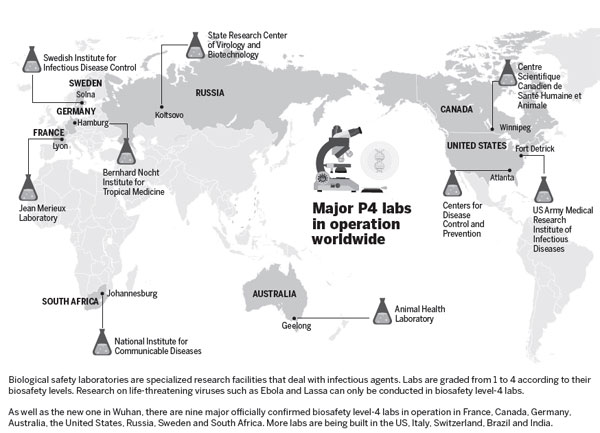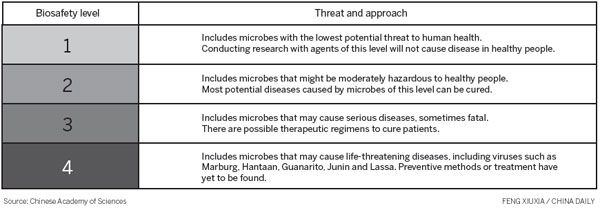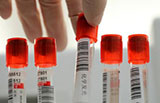Lab joins fight against invisible killers
By Cheng Yingqi in Wuhan (China Daily) Updated: 2015-02-06 07:30
|
|
After changing into the suit, the researchers take a disinfectant shower and pass through a vacuum room before entering the lab.
"Entering a P4 lab usually takes 30 minutes longer than the time needed to enter a lower-level P3 lab, and you have to go through the same procedures every time you walk from one room to another inside the experiment zone," Hu said.
"As a result, an experiment that takes no more than half an hour in normal circumstances will take two to three hours in a P4 laboratory."
The air in the experiment zone is kept at a much lower pressure than the atmosphere outside the building, and this partial vacuum helps to prevent contamination.
Yuan said: "Vacuums, waste treatment and rigorous security procedures are at the heart of a P4 laboratory.
"Vacuums ensure that the viruses do not escape through the air; waste treatment prevents them from spreading through waste water or other experimental material; and the procedures protect researchers from infection.
"Everything that enters the experimental zone will not leave there alive - except for the researchers."
Creating such tight containment is easier said than done. It has taken 11 years to build the Wuhan facility since the project was given the green light by the government.
China decided to build a P4 laboratory in 2003, when the outbreak of severe acute respiratory syndrome spread alarm across the country.
There were 8,096 cases and 774 deaths in a number countries, with the majority occurring in Hong Kong between Nov 2002 and July 2003.
Top priority
In April 2003, France's then-prime minister Jean-Pierre Raffarin visited China, and the two countries agreed to cooperate over infectious disease control. The construction of the P4 laboratory was regarded as a top priority.
"The cooperation with our French partners assured the completion of the P4 facility, improved our capacity to design, construct and operate the laboratory, and helped our personnel training," Yuan said.
The short-term goal of the laboratory is to carry out research on two or three viruses that pose the most immediate threat to China, including Ebola.
In the long run, it aims to become the World Health Organization's fifth reference laboratory - such labs are able to identify unknown emerging infectious diseases.
"There are no national boundaries for disease control," Yuan said. "We expect to extend our cooperation to all other P4 laboratories to make our laboratory a significant platform for virus research worldwide."
- Govt encourages people to work 4.5 days a week
- Action to be taken as HIV cases among students rise
- Debate grows over reproductive rights
- Country's first bishop ordained in 3 years
- China builds Tibetan Buddhism academy in Chengdu
- Authorities require reporting of HIV infections at schools
- Typhoon Soudelor kills 14 in East China
- Police crack down on overseas gambling site
- Debate over death penalty for child traffickers goes on
- Beijing to tighten mail security for war anniversary









